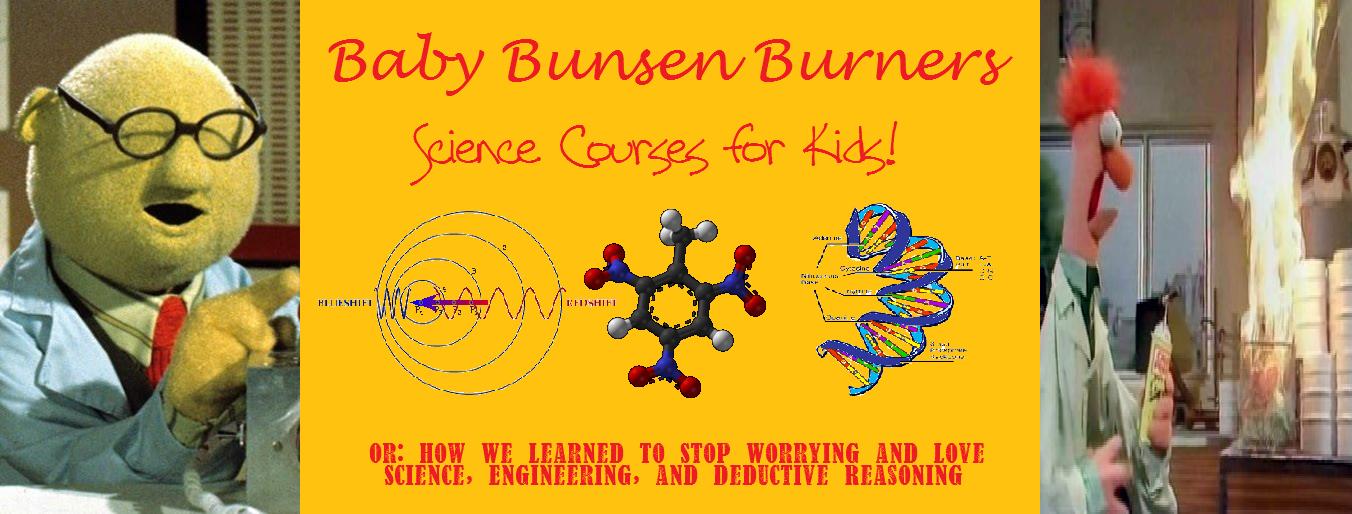Week 1:
Monday - Aerodynamics and the Scientific Method
Tuesday - Hot Air Balloons and Propulsion Methods
Wednesday - Air Pressure
Thursday - Bottle Rockets (construction)
Friday - Bottle Rockets (launch day)
Week 2:
Monday - Model of the Atom
Tuesday - Density, Polarity, and other Chemical Properties
Wednesday - Phase Changes
Thursday - Weird Substances and Cool Chemistry I
Friday - Weird Substances and Cool Chemistry II
Week 3:
Monday - Forensics
Tuesday - Construction, Material Sciences, and Engineering
Wednesday - Solar System and Astronomy
Thursday - Egg Drop (construction)
Friday - Egg Drop (deployment)
Week 4:
Monday - Magnetism
Tuesday - Electricity and Circuits
Wednesday - Optics and/or Sound and Harmonics
Thursday - Cell Modelling
Friday - DNA
Week 5:
Monday - Evolution and Adaptation Games I
Tuesday - Evolution and Adaptation Games II
Wednesday - Bones
Thursday - Fingerprints
Friday - Plants, Botany and the Nitrogen Cycle
Week 6:
Monday - Environmental Science
Tuesday - Carbon Cycle and Climate Change
Wednesday - Volcanoes!
Thursday - Diet Coke and Mentos
Friday - Ice Cream and Food Science
Any suggestions as to course content (particularly for the Weird Substances and Cool Chemistry section, as well as Evolution and Adaptation Games) would be most appreciated.
The topics of the preceding week aim to establish a basis for the larger Thursday/Friday projects, such as Bottle Rockets, and Egg Drop.
Tuesday - Hot Air Balloons and Propulsion Methods
Wednesday - Air Pressure
Thursday - Bottle Rockets (construction)
Friday - Bottle Rockets (launch day)
Week 2:
Monday - Model of the Atom
Tuesday - Density, Polarity, and other Chemical Properties
Wednesday - Phase Changes
Thursday - Weird Substances and Cool Chemistry I
Friday - Weird Substances and Cool Chemistry II
Week 3:
Monday - Forensics
Tuesday - Construction, Material Sciences, and Engineering
Wednesday - Solar System and Astronomy
Thursday - Egg Drop (construction)
Friday - Egg Drop (deployment)
Week 4:
Monday - Magnetism
Tuesday - Electricity and Circuits
Wednesday - Optics and/or Sound and Harmonics
Thursday - Cell Modelling
Friday - DNA
Week 5:
Monday - Evolution and Adaptation Games I
Tuesday - Evolution and Adaptation Games II
Wednesday - Bones
Thursday - Fingerprints
Friday - Plants, Botany and the Nitrogen Cycle
Week 6:
Monday - Environmental Science
Tuesday - Carbon Cycle and Climate Change
Wednesday - Volcanoes!
Thursday - Diet Coke and Mentos
Friday - Ice Cream and Food Science
Any suggestions as to course content (particularly for the Weird Substances and Cool Chemistry section, as well as Evolution and Adaptation Games) would be most appreciated.
The topics of the preceding week aim to establish a basis for the larger Thursday/Friday projects, such as Bottle Rockets, and Egg Drop.




substances & chemistry: Shear-thickening fluids (corn starch in water). Appropriately messy and fun to play with. I also know plenty of good demos if you want (e.g. explosions, glowing things, elephant toothpaste), but I expect that most wouldn't really be age-appropriate (because the best demos are always explosions). (Elephant toothpaste would probably work pretty well, though). Also, piezoelectric materials are awesome, but may be hard to make exciting to kids.
ReplyDeleteAlso, the salts/flame colors experiment is always a good one, and you could make a neat demo with it. And explaining the chemistry behind it is pretty easy, if they understand the Bohr model and discrete energy levels.
Wow, you're like teaching these elementary school kids everything I learned in HS. These kids will be geniuses.
ReplyDelete